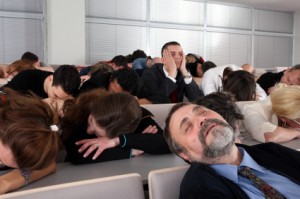When I was in law school I helped a friend with her divorce. I prepared the Petition (yes, under supervision) and served it.
In those days, even though there were no children or real property and the matter was uncontested, she had to appear in court. I went with her to the hearing in downtown Los Angeles and we waited in the hallway for the courtroom to open.
I’d never seen my friend so nervous. She had never been in a courtroom and was afraid she wouldn’t know what to say. I told her this was a very simple case, the judge would ask a few basic questions and everything would be over in a few minutes. I kept talking, trying to calm her down, but nothing seemed to work. She was visibly shaking and barely able to speak.
Finally, I said, “Oh, here comes the judge.” I was looking over her shoulder behind her. She turned to look. Coming towards us was a shabbily dressed old man with dirty, unruly hair and an unshaven face. It was not the judge of course but a homeless man and the sight of him shuffling down the hall made her laugh.
A good laugh was exactly what the doctor ordered. My friend was able to get through the hearing and soon, we were on our way home.
In the car, she thanked me for helping her and especially for helping her to calm down enough to get through the hearing. It meant a lot to her that I cared enough to do that. We are still very good friends today, more than thirty years later.
So, why did I tell you this story? I could have simply made the point that your clients want to know you care about them and really do appreciate the little things you say or do.
Telling you that story was a better way to make that point, don’t you think?
I talk a lot about using stories in your writing and presentations. You’ve often heard me say, “facts tell but stories sell” and I’ve explained why:
- Stories have people in them and the reader or listener can relate to them and their experiences.
- Stories have a dramatic theme; people want to know, “what happened next?”
- Stories have verisimilitude; they “show” instead of “tell,” and are often more persuasive than a logical argument
- Stories appeal to human emotion. When you make people feel something, you connect with them on a deeper level.
- People remember stories long after the facts are forgotten.
As you read my story, I hope you were you able to see my friend and me in that hallway and you could relate to the experience of trying to comfort a nervous client. If you could, then my story did double duty–it made the point about showing clients you care and it showed you why you need to put more stories in your writing and presentations.











How to get people talking about you and your law practice
One of the best ways to help people understand what you do is to tell stories about the clients and cases you’ve handled in the past. All of your marketing documents and messages should be peppered with client stories for reasons I’ve written about before.
But if you want people to talk about you and remember you and send business to you, there’s one more story you need to tell: your story.
People are fascinated by lawyers. Yes, they criticize us and make jokes about us, but at the same time, they love to watch TV dramas and read novels featuring attorneys.
Of course we know that the real world of practicing law is not anything like that depicted on TV. By and large, what we do is boring.
Nevertheless, your clients and prospects and social media fans and followers believe you lead a fascinating life. They would love to peek behind the curtain to see what you do.
Don’t tell them. Remember, what you do is boring.
But who you are is not.
Tell them your story. What drives you? What gets you out of bed in the morning, ready to slay dragons and save princesses? Why do you do what you do?
Share your passion for your work and insights into who you are. What fascinated you when you were growing up? Who influenced you? What experiences made you the person you are today?
Share your feelings and beliefs, desires and dreams, and even your fears. Let people see that you are a real person, just like them.
Real stories, of course, have a dramatic arc. There is controversy, disagreement, hardship, struggle. Our hero (that’s you) wants something, but there are obstacles in the way. The dragon doesn’t roll over and die, you have to slay him.
Find the dramatic story of your life and tell it. It’s what makes you unique and memorable. It’s what will help you stand out in the crowd.
Your story will attract people and get them talking about you and sending you business. And hey, if your story is good enough, one day we might see it on TV.